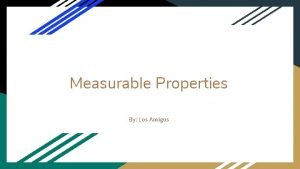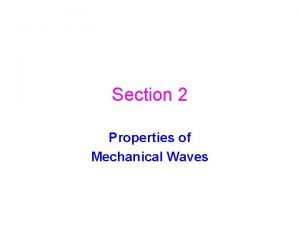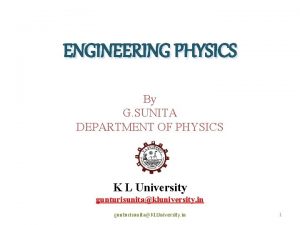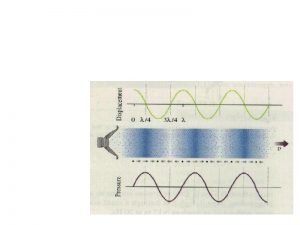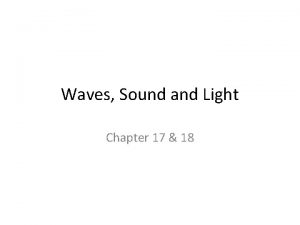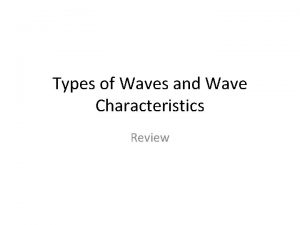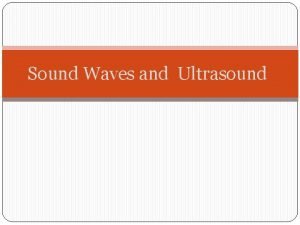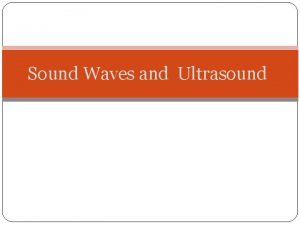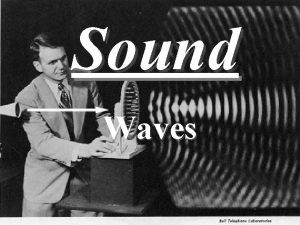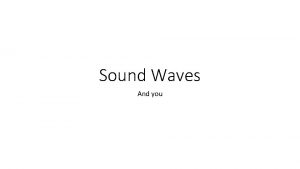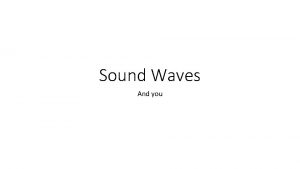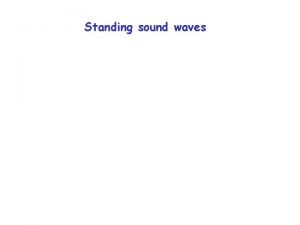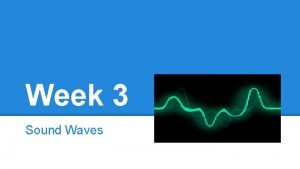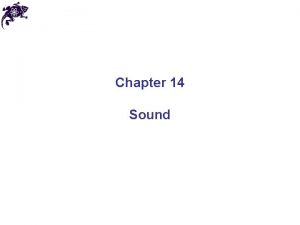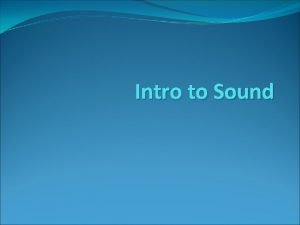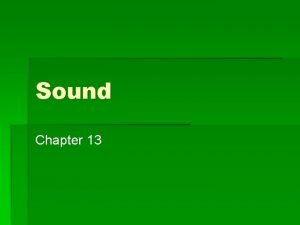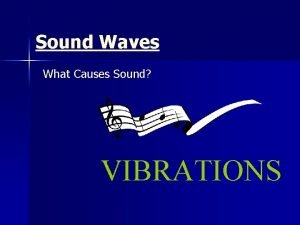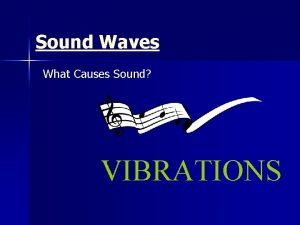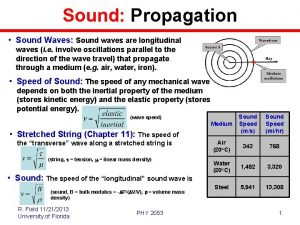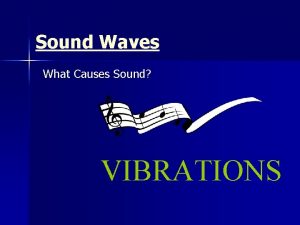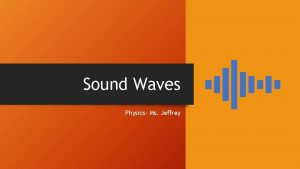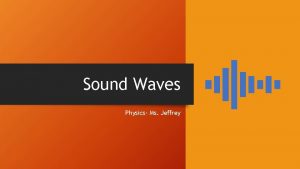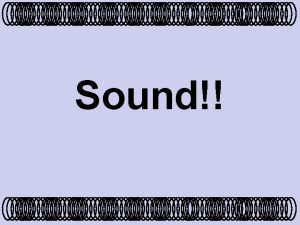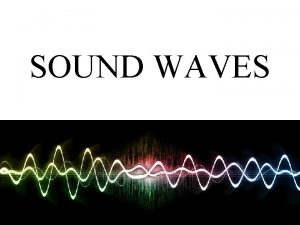Properties of Sound Making Waves Sound Waves Sound




























- Slides: 28

Properties of Sound Making Waves

Sound Waves ■Sound is created by vibrations

Sound Waves ■Sound is created by vibrations ■Vibrations move air molecules near them

Sound Waves ■Sound is created by vibrations ■Vibrations move air molecules near them ■Molecules forced together, raise air pressure

Sound Waves ■Sound is created by vibrations ■Vibrations move air molecules near them ■Molecules forced together, raise air pressure ■Pressure is transferred to other molecules

Sound Waves ■Sound is created by vibrations ■Vibrations move air molecules near them ■Molecules forced together, raise air pressure ■Pressure is transferred to other molecules ■This causes a ‘Wave of Pressure’.


High 0 line Low ■Zero line is pressure of air at rest

High 0 line Low ■Zero line is pressure of air at rest ■High points represent higher pressure

High 0 line Low ■Zero line is pressure of air at rest ■High points represent higher pressure ■Low points represent lower pressure

Cycle Amplitude ■Amplitude - change in pressure from a wave’s highest point, to it’s lowest point

Cycle Amplitude ■Amplitude - change in pressure from a wave’s highest point, to it’s lowest point ■Cycle - refers to the time it takes for the wave to go from one amplitude, through all its changes. . . to the same amplitude again.

■Frequency - the number of cycles per second

■Frequency - the number of cycles per second ■One Hertz - equals ONE cycle per second ■ 1000 Hz = 1000 Cycles per second.

■Sound is converted to electrical energy and sent through wires

■For transmission, sound is converted to electrical energy and sent through wires

■For transmission, sound is converted to electrical energy and sent through wires ■Analog - recorded on cassette tape as changes in magnetic strength

■For transmission, sound is converted to electrical energy and sent through wires ■Analog - recorded on cassette tape as changes in magnetic strength ■Digital – recorded and stored on a hard drive as a ‘file’.

■Analog Recordings - sample the wave forms at peaks and valleys

■Analog Recordings - sample the wave forms at peaks and valleys ■Digital Audio - samples the sound and turns it in to 1's and 0's

■Analog Recordings - sample the wave forms at peaks and valleys ■Digital Audio - samples the sound and turns it in to 1's and 0's ■The higher the sample rate the greater the number of sampling points per second

■Analog Recordings - sample the wave forms at peaks and valleys ■Digital Audio - samples the sound and turns it in to 1's and 0's ■The higher the sample rate the greater the number of sampling points per second.

■Lower sampling rates do not capture the true sound being recorded

■Lower sampling rates do not capture the true sound being recorded ■Sampling rate must be at least TWICE the frequency

■Lower sampling rates do not capture the true sound being recorded ■Sampling rate must be at least TWICE the frequency ■Therefore if frequency is 8000 Hz. . . the sampling rate must be at least 16, 000 times per second

■Lower sampling rates do not capture the true sound being recorded ■Sampling rate must be at least TWICE the frequency ■Therefore if frequency is 8000 Hz. . . the sampling rate must be at least 16, 000 times per second ■A CD recording is sampled 44, 000 times per second.

2 Identical Sound Clips (Grey) Sampled at 2 different rates (Blue)

Audio Task ■Open the Sound FX Assignment sheet in the Handout Folder. Write a short script and download all your FX files to your folder ■Using Sound Forge edit your short story then Export it as an MP 3 file to your Folder.
 Light is an electromagnetic wave true or false
Light is an electromagnetic wave true or false Difference between electromagnetic waves and sound waves
Difference between electromagnetic waves and sound waves The wave chapter 13
The wave chapter 13 Is echolocation transverse or longitudinal
Is echolocation transverse or longitudinal What waves do not require a medium
What waves do not require a medium Venn diagram mechanical and electromagnetic waves
Venn diagram mechanical and electromagnetic waves Short wave vs long wave radiation
Short wave vs long wave radiation Difference between matter waves and electromagnetic waves
Difference between matter waves and electromagnetic waves Mechanical vs electromagnetic waves
Mechanical vs electromagnetic waves Mechanical and electromagnetic waves similarities
Mechanical and electromagnetic waves similarities Seismic waves
Seismic waves Seismic waves are mechanical waves
Seismic waves are mechanical waves Compare and contrast p waves and s waves using venn diagram
Compare and contrast p waves and s waves using venn diagram Mechanical and electromagnetic waves venn diagram
Mechanical and electromagnetic waves venn diagram Constructive
Constructive Is making inference simply making a guess
Is making inference simply making a guess War making and state making as organized crime
War making and state making as organized crime Kesler science
Kesler science Basic properties of waves
Basic properties of waves Detail the measurable properties for all waves
Detail the measurable properties for all waves Property of mechanical waves
Property of mechanical waves Properties of mechanical waves
Properties of mechanical waves Properties of mechanical waves
Properties of mechanical waves Magnetostriction method to produce ultrasonic waves
Magnetostriction method to produce ultrasonic waves 4 basic properties of waves
4 basic properties of waves What is intensive in chemistry
What is intensive in chemistry Physical properties of ice cube
Physical properties of ice cube What is mechanical wave
What is mechanical wave Sound waves from a radio generally travel in which medium?
Sound waves from a radio generally travel in which medium?



















